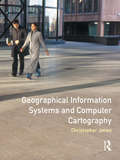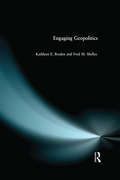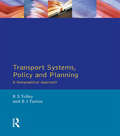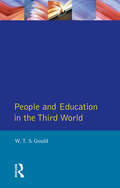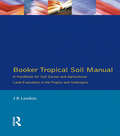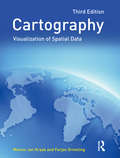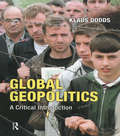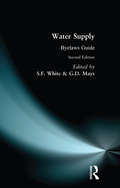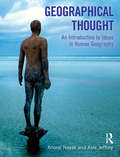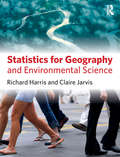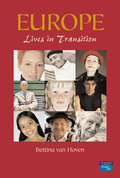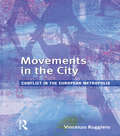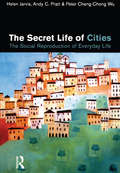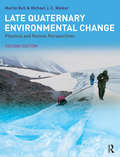- Table View
- List View
Geographical Information Systems and Computer Cartography
by Chris B. JonesA concise text presenting the fundamental concepts in Geographical Information Systems (GIS), emphasising an understanding of techniques in management, analysis and graphic display of spatial information.Divided into five parts - the first part reviews the development and application of GIS, followed by a summary of the characteristics and representation of geographical information. It concludes with an overview of the functions provided by typical GIS systems. Part Two introduces co-ordinate systems and map projections, describes methods for digitising map data and gives an overview of remote sensing. Part Three deals with data storage and database management, as well as specialised techniques for accessing spatial data. Spatial modelling and analytical techniques for decision making form the subject of Part Four, while the final part is concerned with graphical representation, emphasising issues of graphics technology, cartographic design and map generalisation.
Geographical Information Systems and Computer Cartography
by Chris B. JonesA concise text presenting the fundamental concepts in Geographical Information Systems (GIS), emphasising an understanding of techniques in management, analysis and graphic display of spatial information.Divided into five parts - the first part reviews the development and application of GIS, followed by a summary of the characteristics and representation of geographical information. It concludes with an overview of the functions provided by typical GIS systems. Part Two introduces co-ordinate systems and map projections, describes methods for digitising map data and gives an overview of remote sensing. Part Three deals with data storage and database management, as well as specialised techniques for accessing spatial data. Spatial modelling and analytical techniques for decision making form the subject of Part Four, while the final part is concerned with graphical representation, emphasising issues of graphics technology, cartographic design and map generalisation.
Engaging Geopolitics
by Kathleen E Braden Fred M ShelleyEngaging Geopolitics provides a comprehensive introduction to the influence of geography, demography and economics on politics and international relations in the world in which we live today. The authors' expressed aim is to make geopolitics more accessible to undergraduate students, with the hope that the book will be an ideal starting pointing for those who will be moving vertically into more advanced courses in political geography or laterally into other concerns of international affairs.
Transport Systems, Policy and Planning: A Geographical Approach
by Rodney Tolley Brian John TurtonProvides a unique review of the major spatial aspects of transport systems, a detailed analysis of transport problems in urban and rural areas, an evaluation of social and environmental impacts, and a planning and policy overview. Divided into four parts, each considering a different aspect of transport geography. The first part outlines the basic geography of transport and examines transport and spatial structures, focusing upon the varying contributions made by transport to industrial, agricultural and urban development. Part two moves to consider specific transport systems at both national and international scales, drawing on studies from industrialised and developing nations and discussing the effects upon transport of the political changes in the former USSR and Eastern Europe. The third part examines some of the many problems of transport and urban and rural areas using specific examples to illustrate the contrasting difficulties and evaluate current urban transportation planning methods.
Transport Systems, Policy and Planning: A Geographical Approach
by Rodney Tolley Brian John TurtonProvides a unique review of the major spatial aspects of transport systems, a detailed analysis of transport problems in urban and rural areas, an evaluation of social and environmental impacts, and a planning and policy overview. Divided into four parts, each considering a different aspect of transport geography. The first part outlines the basic geography of transport and examines transport and spatial structures, focusing upon the varying contributions made by transport to industrial, agricultural and urban development. Part two moves to consider specific transport systems at both national and international scales, drawing on studies from industrialised and developing nations and discussing the effects upon transport of the political changes in the former USSR and Eastern Europe. The third part examines some of the many problems of transport and urban and rural areas using specific examples to illustrate the contrasting difficulties and evaluate current urban transportation planning methods.
People and Education in the Third World
by W. T. GouldFirst published in 1993. Routledge is an imprint of Taylor & Francis, an informa company.
People and Education in the Third World
by W. T. GouldFirst published in 1993. Routledge is an imprint of Taylor & Francis, an informa company.
Booker Tropical Soil Manual: A Handbook for Soil Survey and Agricultural Land Evaluation in the Tropics and Subtropics
by J. R. LandonFirst published in 1991. Routledge is an imprint of Taylor & Francis, an informa company.
Booker Tropical Soil Manual: A Handbook for Soil Survey and Agricultural Land Evaluation in the Tropics and Subtropics
by J. R. LandonFirst published in 1991. Routledge is an imprint of Taylor & Francis, an informa company.
Cartography: Visualization of Spatial Data
by Menno-Jan Kraak F. J. OrmelingThis revised and updated edition integrates the latest in modern technology with traditional cartographic principles. While providing a solid conceptual foundation in cartographic methodology, the text also introduces the very latest advances that have greatly influenced cartographic techniques. The new edition reflects the increasing importance of cartography as the basis for further geographical study, the text has been updated throughout and chapters on the latest developments in cartography have been integrated. There is also a more widespread emphasis on multimedia and the web.
Cartography: Visualization of Spatial Data
by Menno-Jan Kraak F. J. OrmelingThis revised and updated edition integrates the latest in modern technology with traditional cartographic principles. While providing a solid conceptual foundation in cartographic methodology, the text also introduces the very latest advances that have greatly influenced cartographic techniques. The new edition reflects the increasing importance of cartography as the basis for further geographical study, the text has been updated throughout and chapters on the latest developments in cartography have been integrated. There is also a more widespread emphasis on multimedia and the web.
Urban Social Geography: An Introduction
by Paul Knox Steven PinchThe 6th edition of this highly respected text builds upon the successful structure, engaging writing style and clear presentation of previous editions. Examining urban social geography from a theoretical and historical perspective, it also explores how it has developed into the modern day. Taking account of recent critical work, whilst simultaneously presenting well established approaches to the subject, it ensures students are well-informed about all the issues. The result is a topical book that is clear and accessible for students
Urban Social Geography: An Introduction
by Paul Knox Steven PinchThe 6th edition of this highly respected text builds upon the successful structure, engaging writing style and clear presentation of previous editions. Examining urban social geography from a theoretical and historical perspective, it also explores how it has developed into the modern day. Taking account of recent critical work, whilst simultaneously presenting well established approaches to the subject, it ensures students are well-informed about all the issues. The result is a topical book that is clear and accessible for students
Global Geopolitics: A Critical Introduction
by Klaus J. DoddsEmploying thematic investigation and illustrated through case studies, Dodds explores how global politics is imagined and practised by countries such as the US and other organisations including Greenpeace, the IMF and CNN International.In addition, the author discusses how issues such as environmental degradation, terror networks, anti-globalisation protests and North-South relations challenge, consolidate and subvert the existing international political system.
Global Geopolitics: A Critical Introduction
by Klaus J. DoddsEmploying thematic investigation and illustrated through case studies, Dodds explores how global politics is imagined and practised by countries such as the US and other organisations including Greenpeace, the IMF and CNN International.In addition, the author discusses how issues such as environmental degradation, terror networks, anti-globalisation protests and North-South relations challenge, consolidate and subvert the existing international political system.
Water Supply Byelaws Guide
by S. F. White G. D. MaysFirst published in 1990. Routledge is an imprint of Taylor & Francis, an informa company.
Geographical Thought: An Introduction to Ideas in Human Geography
by Anoop Nayak Alex JeffreyGeographical Thought provides a clear and accessible introduction to the key ideas and figures in human geography. The book provides an essential introduction to the theories that have shaped the study of societies and space. Opening with an exploration of the founding concepts of human geography in the nineteenth century academy, the authors examine the range of theoretical perspectives that have emerged within human geography over the last century from feminist and marxist scholarship, through to post-colonial and non-representational theories. Each chapter contains insightful lines of argument that encourage readers towards independent thinking and critical evaluation. Supporting materials include a glossary, visual images, further reading suggestions and dialogue boxes.
Geographical Thought: An Introduction to Ideas in Human Geography
by Anoop Nayak Alex JeffreyGeographical Thought provides a clear and accessible introduction to the key ideas and figures in human geography. The book provides an essential introduction to the theories that have shaped the study of societies and space. Opening with an exploration of the founding concepts of human geography in the nineteenth century academy, the authors examine the range of theoretical perspectives that have emerged within human geography over the last century from feminist and marxist scholarship, through to post-colonial and non-representational theories. Each chapter contains insightful lines of argument that encourage readers towards independent thinking and critical evaluation. Supporting materials include a glossary, visual images, further reading suggestions and dialogue boxes.
Statistics for Geography and Environmental Science
by Richard Harris Claire JarvisStatistics are important tools for validating theory, making predictions and engaging in policy research. They help to provide informed commentary about social and environmental issues, and to make the case for change. Knowledge of statistics is therefore a necessary skill for any student of geography or environmental science. This textbook is aimed at students on a degree course taking a module in statistics for the first time. It focuses on analysing, exploring and making sense of data in areas of core interest to physical and human geographers, and to environmental scientists. It covers the subject in a broadly conventional way from descriptive statistics, through inferential statistics to relational statistics but does so with an emphasis on applied data analysis throughout.
Statistics for Geography and Environmental Science
by Richard Harris Claire JarvisStatistics are important tools for validating theory, making predictions and engaging in policy research. They help to provide informed commentary about social and environmental issues, and to make the case for change. Knowledge of statistics is therefore a necessary skill for any student of geography or environmental science. This textbook is aimed at students on a degree course taking a module in statistics for the first time. It focuses on analysing, exploring and making sense of data in areas of core interest to physical and human geographers, and to environmental scientists. It covers the subject in a broadly conventional way from descriptive statistics, through inferential statistics to relational statistics but does so with an emphasis on applied data analysis throughout.
Europe: Lives in Transition
by Bettina Van Hoven Tim UnwinFirst published in 2003. Routledge is an imprint of Taylor & Francis, an informa company.
Movements in the City: Conflict in the European Metropolis
by Vincenzo RuggieroFor 2nd and 3rd year courses in urban sociology, sociology of exclusion, social stratification, planning and cultural studies in departments of sociology and urban geography. This book provides an in depth examination of social movements and urban life in European cities today. Unique in its interdisciplinary approach, it covers traditional areas of urban studies, sociological concerns about the concept of change and the characteristics of social movements. It presents current theory as well as discursive sections based around empirical work conducted in major European cities including London, Paris and Berlin.
Movements in the City: Conflict in the European Metropolis
by Vincenzo RuggieroFor 2nd and 3rd year courses in urban sociology, sociology of exclusion, social stratification, planning and cultural studies in departments of sociology and urban geography. This book provides an in depth examination of social movements and urban life in European cities today. Unique in its interdisciplinary approach, it covers traditional areas of urban studies, sociological concerns about the concept of change and the characteristics of social movements. It presents current theory as well as discursive sections based around empirical work conducted in major European cities including London, Paris and Berlin.
The Secret Life of Cities: Social reproduction of everyday life
by Helen Jarvis Andy C. Pratt Peter Cheng-Chong WuContemporary urbanisation has two faces: global flows of people, money and information, and that of localised social and economic disparities. Recent research has focused on the headlines of global cities as control centres of the world economy, and social and economic shock waves that have raged through cities and regions, but less attention has been paid to the secret life of cities, and the changing nature of everyday life in the wake of such changes.This book challenges current research and policy agendas recommending spatial concentration and relocation as a solution to the problems of environmental sustainability and social dislocation. Instead, this book highlights the key linkages between social and environmental problems, it argues that neither are likely to be resolved with a simple spatial fix. The book draws attention to local contexts of contemporary urbanisation emphasising consideration of policy making from the perspective of the household as a key unit of analysis in identifying links between labour and housing markets, transport and leisure.This book draws upon detailed household interviews about the daily experience of life in a global city. It illustrates the dilemmas and solutions that people routinely find in order to go on in their lives. It shows that these local fixes that are managed at the level of the household work in spite of, and sometimes against, existing policies aimed at sustainability. It concludes that policy making needs to be radically overhauled in order to address the integrated nature of people's everyday lives.
Late Quaternary Environmental Change: Physical and Human Perspectives
by Martin Bell M.J.C. WalkerLate Quaternary Environmental Change addresses the interaction between human agency and other environmental factors in the landscapes, particularly of the temperate zone.Taking an ecological approach, the authors cover the last 20,000 years during which the climate has shifted from arctic severity to the conditions of the present interglacial environment.
